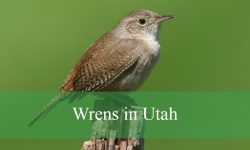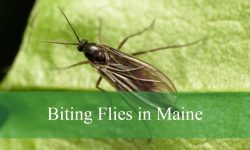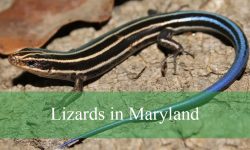Texas is home to an incredible diversity of reptiles, and among them, lizards are some of the most commonly seen. The wide variety of ecosystems across the state—from deserts and forests to grasslands and urban spaces—supports dozens of unique species. The many types of lizards in Texas showcase a broad range of shapes, colors, and behaviors, making them fascinating to observe in the wild.
Some lizards in Texas are tiny and fast, like whiptails and skinks, while others are slow-moving and heavily armored, such as horned lizards. Native and non-native species alike have carved out niches across the state, each with distinct patterns, habits, and preferred environments. Their adaptability and presence in both rural and residential areas make them a frequent sight across much of Texas.
This guide covers 60 unique types of lizards in Texas, complete with detailed descriptions, identification tips, and insights into their natural habitats. Whether spotted on a rocky trail or sunning on a garden wall, these lizards offer a closer look at the rich biodiversity thriving in every corner of Texas.
Different Types of Lizards in Texas
Texas Horned Lizard (Phrynosoma cornutum)
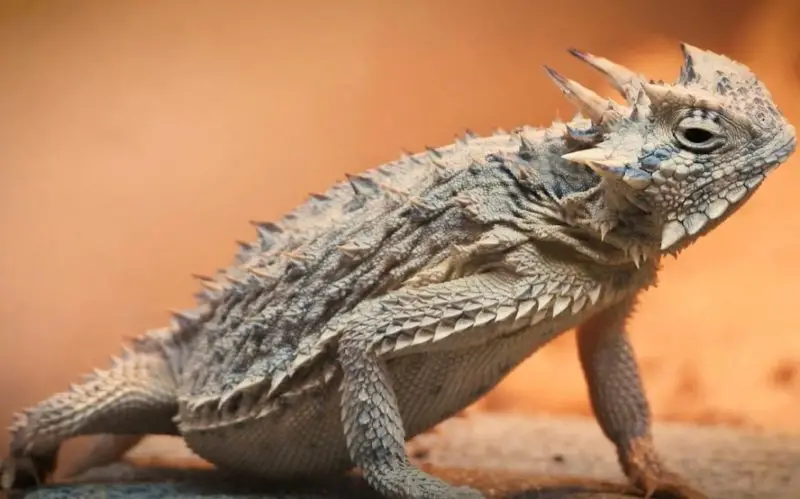
The Texas Horned Lizard is a distinctive reptile known for its broad, flattened body and the prominent spines that resemble horns on its head and body. Its coloration varies from sandy tan to reddish-brown, allowing it to blend seamlessly with the arid landscapes of Texas. This lizard typically measures around 4 to 6 inches in length and has a slow, deliberate movement that helps it avoid detection by predators.
Identifying the Texas Horned Lizard is straightforward due to its unique spiky appearance and squat, round shape. Its horns are not just for show; they serve as a defense mechanism to deter predators. When threatened, it can even squirt blood from its eyes as a last-resort defense. These lizards primarily feed on ants, especially harvester ants, which constitute a large part of their diet.
In Texas, the Texas Horned Lizard inhabits dry, open areas such as deserts, scrublands, and grasslands. It prefers sandy or loose soils where it can dig burrows and hide from predators and extreme weather. Unfortunately, habitat loss and pesticide use have reduced their numbers, but they remain an iconic species of the southwestern United States.
Common Spotted Whiptail (Aspidoscelis gularis)
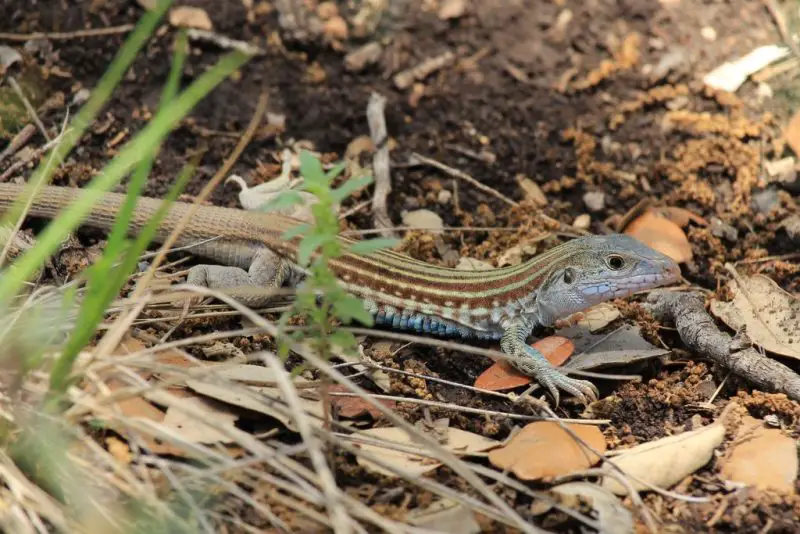
The Common Spotted Whiptail is a slender, fast-moving lizard with a distinctive spotted pattern on its back. Its coloration is typically brown or gray with darker spots that provide excellent camouflage among leaf litter and rocky environments. This species is relatively small, averaging 4 to 6 inches in length, and has a long, whip-like tail that aids in balance and quick escapes.
Recognizing the Common Spotted Whiptail involves noting its smooth, shiny scales and the spotted markings across its body and tail. Its movements are rapid and energetic, often seen darting through underbrush or along rocky slopes. Unlike some lizards, it does not rely on spines for protection but instead depends on speed and agility.
The habitat of the Common Spotted Whiptail in Texas ranges from dry woodlands to rocky hillsides and brushy areas. It prefers warm environments and is diurnal, most active during the day when it hunts for insects and other small invertebrates. This species plays a vital role in controlling insect populations and is an important part of the local ecosystem.
Slender Glass Lizard (Ophisaurus attenuatus)
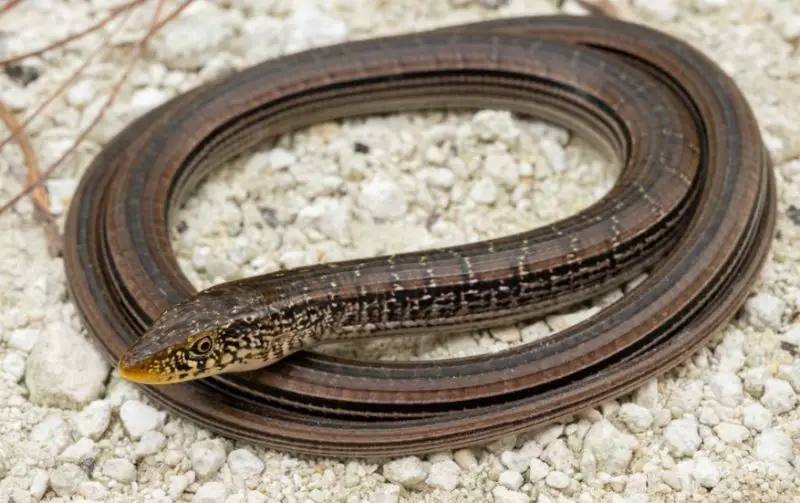
The Slender Glass Lizard is a fascinating reptile that resembles a snake but is actually a legless lizard. It has a long, slender body covered with smooth scales and can grow up to 20 inches in length. Its coloration is usually tan or brown with subtle dark stripes running along its body, which helps it blend into grassy and wooded habitats.
One of the key identification features of the Slender Glass Lizard is its eyelids and external ear openings, which differentiate it from snakes. It has a fragile tail that can break off easily to escape predators, a characteristic shared by many lizards known as caudal autotomy. When the tail breaks, it continues to wriggle, distracting predators while the lizard escapes.
In Texas, the Slender Glass Lizard is found in a variety of habitats including grasslands, open woodlands, and sandy areas. It prefers habitats with plenty of ground cover where it can hide from threats. This lizard feeds primarily on insects, spiders, and small vertebrates. Its elusive nature and snake-like appearance often cause confusion among casual observers.
Rose-bellied Lizard (Sceloporus variabilis)

The Rose-bellied Lizard is a medium-sized spiny lizard noted for its striking coloration, especially the pinkish or rose-colored belly in males during the breeding season. The back is covered in rough, keeled scales and is generally gray or brown with darker markings that provide camouflage on rocky terrain. Adult sizes range from 4 to 7 inches long.
Identification of this species is marked by its colorful throat and belly patches, which males use to display dominance and attract mates. The Rose-bellied Lizard is active and alert, often seen basking on rocks or darting between crevices. Its spiny scales provide some protection against predators and rough environmental conditions.
This lizard prefers rocky hillsides, canyons, and semi-arid regions in Texas, where it can find plenty of sun-exposed surfaces to regulate its body temperature. It feeds mainly on insects and small arthropods, actively hunting throughout the day. The Rose-bellied Lizard is an important predator of pest insects in its habitat.
Brown Anole (Anolis sagrei)

The Brown Anole is a small, agile lizard originally native to the Caribbean but now widespread in Texas. It has a brown or gray body with darker patterns and a distinctive dewlap (throat fan) that males display during territorial and mating behaviors. Adults typically measure around 5 to 8 inches from snout to tail tip.
This species is easily recognized by its quick movements, slender body, and the males’ brightly colored dewlap that can be orange, red, or yellow. Brown Anoles are excellent climbers, often seen on trees, fences, and walls. They are highly territorial and use their dewlap displays and head bobbing to communicate and establish dominance.
In Texas, Brown Anoles thrive in urban and suburban environments as well as natural habitats like forests and scrublands. They feed primarily on insects and other small invertebrates, making them beneficial for pest control. Their adaptability has allowed them to expand their range and coexist with native lizard species.
Greater Earless Lizard (Cophosaurus texanus)
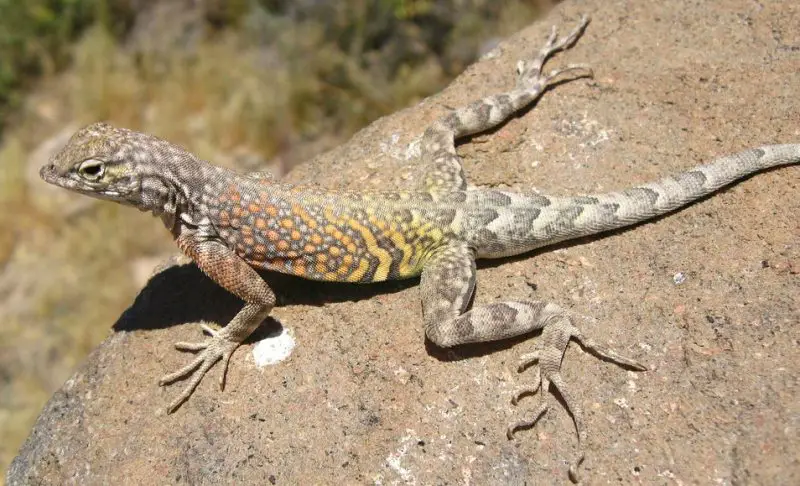
The Greater Earless Lizard is known for its lack of external ear openings, which gives it a smooth appearance around the head. It has a long, slender body with a rough, scaly texture and a tail that is often twice the length of its body. Its coloration varies from gray to tan with dark bands or blotches, helping it blend into the rocky and sandy habitats of Texas.
This lizard is easily identified by its large size compared to other earless lizards and the absence of visible ear holes. Males often display bright blue patches on their bellies during the breeding season to attract females and assert dominance. They are quick and agile, using speed as their main defense against predators.
In Texas, the Greater Earless Lizard is typically found in open, arid regions such as deserts and rocky hillsides. It is active during the day and feeds mainly on insects, spiders, and other small invertebrates. This species plays an important role in its ecosystem by controlling insect populations and serving as prey for larger animals.
Green Anole (Anolis carolinensis)

The Green Anole is a small, slender lizard famous for its bright green coloration, although it can change to brown depending on mood or environmental conditions. It has a pointed snout and a long tail, measuring about 5 to 8 inches in length. The males feature a pinkish-red dewlap used in territorial and courtship displays.
Identification of the Green Anole is straightforward due to its vibrant green color and the ability to change color for camouflage or social signaling. They are agile climbers, frequently seen on trees, shrubs, and walls. Their behavior includes head bobbing and dewlap extension during interactions with rivals or potential mates.
In Texas, Green Anoles prefer humid environments such as woodlands, gardens, and suburban yards. They hunt small insects and spiders and are primarily active during the day. Their adaptability to urban areas has made them a common sight across many parts of the state, contributing to insect control.
Little Brown Skink (Scincella lateralis)
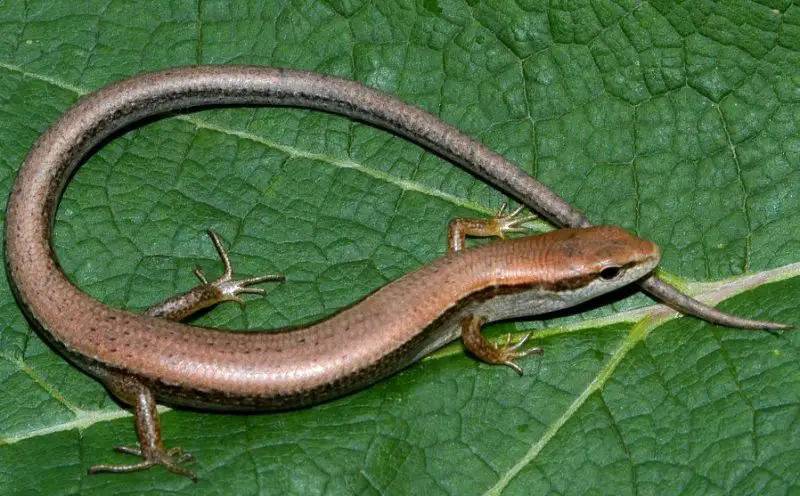
The Little Brown Skink is a small, smooth-scaled lizard with a shiny, brownish body and a slender build. Measuring around 3 to 5 inches in length, this species is often mistaken for a snake due to its tiny legs and quick movements. It has a light stripe running down the center of its back which can help with identification.
This skink is identifiable by its sleek scales and its tendency to move swiftly through leaf litter and underbrush. Unlike many lizards, it spends much of its time on or under the ground, seeking shelter beneath logs and stones. It is shy and elusive, quickly darting away when disturbed.
In Texas, the Little Brown Skink inhabits moist forests, wooded areas, and shaded gardens. It prefers damp environments rich in leaf litter where it can hunt for small insects, spiders, and other invertebrates. Its secretive lifestyle makes it less commonly seen but it is widespread and abundant in suitable habitats.
Texas Spiny Lizard (Sceloporus olivaceus)

The Texas Spiny Lizard is notable for its rough, keeled scales that give it a spiky appearance, especially on its back and sides. Its coloration ranges from olive to brown with darker blotches, helping it camouflage against tree bark and rocky surfaces. This lizard grows to about 5 to 8 inches long, including the tail.
Identification is aided by its spiny scales and robust body shape. Males often show bright blue patches on their throats and bellies during breeding season, which are used in courtship and territorial displays. This species is diurnal and highly territorial, often seen perched on tree trunks or fences.
In Texas, the Texas Spiny Lizard prefers wooded areas, rocky outcrops, and forest edges where it basks in sunlight. It feeds primarily on insects and other small arthropods, playing an important role in controlling local insect populations. It is one of the more common and easily spotted lizards in its range.
Mediterranean House Gecko (Hemidactylus turcicus)
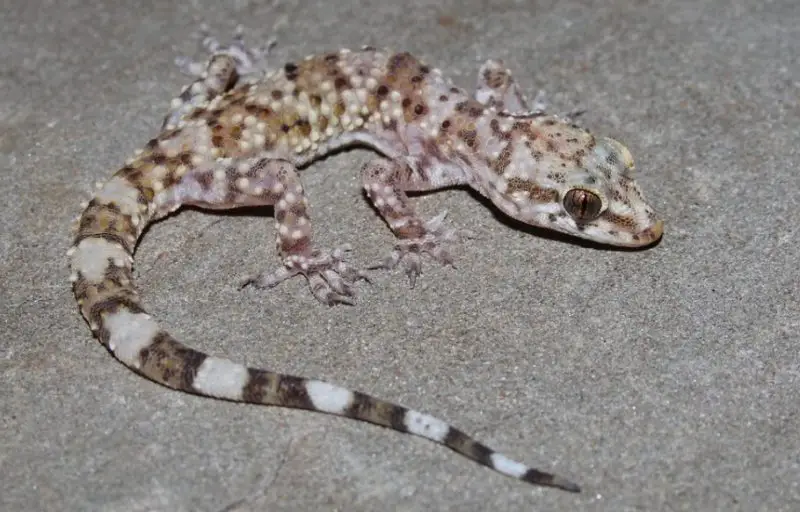
The Mediterranean House Gecko is a small, nocturnal lizard known for its translucent skin and sticky toe pads that enable it to climb smooth surfaces. It is typically pale gray or light brown with small darker spots scattered across its body. Adults usually measure about 3 to 5 inches in length.
This species is easily recognized by its vocalizations, often heard at night, and its preference for human structures. It has large eyes with vertical pupils adapted for low-light environments. The Mediterranean House Gecko feeds primarily on insects attracted to lights around homes and buildings.
In Texas, this gecko is commonly found in urban and suburban areas, often seen on walls, windows, and porch ceilings. Its adaptability to human environments has allowed it to thrive, and it provides natural pest control by feeding on mosquitoes, flies, and other insects.
Common Five-lined Skink (Plestiodon fasciatus)

The Common Five-lined Skink is easily recognized by the five distinctive light stripes running along its dark body, usually black or brown. Juveniles often display a bright blue tail, which fades as they mature. This skink has smooth, shiny scales and grows to about 6 to 8 inches in length, including its tail.
Identification is straightforward due to the prominent stripes and the vibrant blue tail seen in younger individuals. They are agile and fast, often darting under rocks or logs when threatened. Their slender bodies and short legs allow them to navigate through leaf litter and dense vegetation effectively.
In Texas, the Common Five-lined Skink inhabits moist woodlands, forest edges, and rocky hillsides where they can find ample shelter. They are primarily insectivores, feeding on small insects, spiders, and other arthropods. This species plays a key role in controlling insect populations within its habitat.
Ornate Tree Lizard (Urosaurus ornatus)

The Ornate Tree Lizard is a small, slender lizard known for its intricate pattern of spots and stripes across its back, giving it a beautifully decorated appearance. Its coloration ranges from gray to brown with hints of orange or blue during the breeding season, especially in males. Adults usually measure about 4 to 6 inches long.
This lizard is identifiable by its keeled scales and the complex pattern on its body. Males often display brighter colors and engage in territorial behaviors such as head bobbing and dewlap extension. The Ornate Tree Lizard is a skilled climber, commonly seen on tree trunks and branches.
In Texas, it prefers rocky canyons, arid scrublands, and desert environments with plenty of vegetation for cover. It feeds primarily on insects and small invertebrates and is active during the day. Its ability to adapt to harsh environments makes it a resilient species in the southwestern region.
Crevice Spiny Lizard (Sceloporus poinsettii)
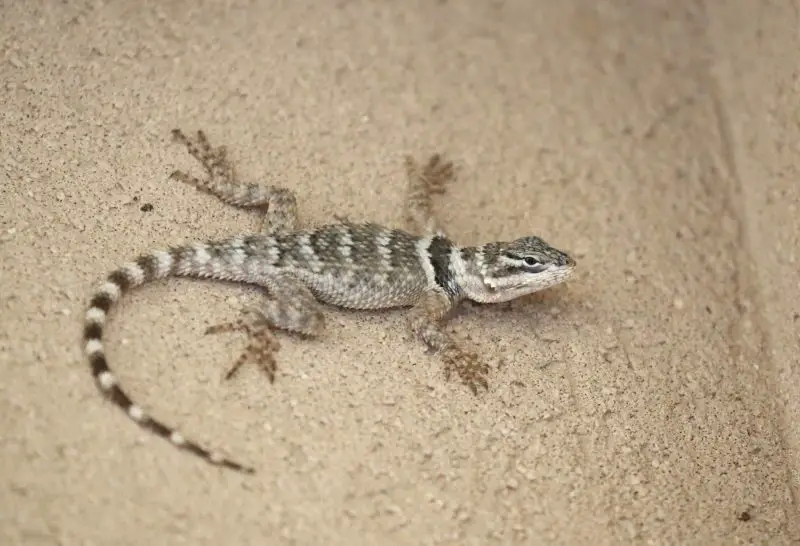
The Crevice Spiny Lizard is a medium-sized lizard distinguished by its rough, spiny scales and mottled gray or brown coloration that helps it blend into rocky habitats. It grows to around 5 to 7 inches long and has a stout body with a short tail relative to its body size.
Identification focuses on its spiny scales and the habitat it favors—rock crevices and ledges where it can hide from predators. This species is territorial and exhibits head bobbing and push-up displays as a form of communication and defense.
In Texas, the Crevice Spiny Lizard is primarily found in rocky outcrops, cliffs, and mountainous regions. It is diurnal and feeds on a diet of insects, spiders, and other small arthropods. Its ability to camouflage among rocks makes it a master of concealment in its preferred environment.
Prairie Lizard (Sceloporus consobrinus)
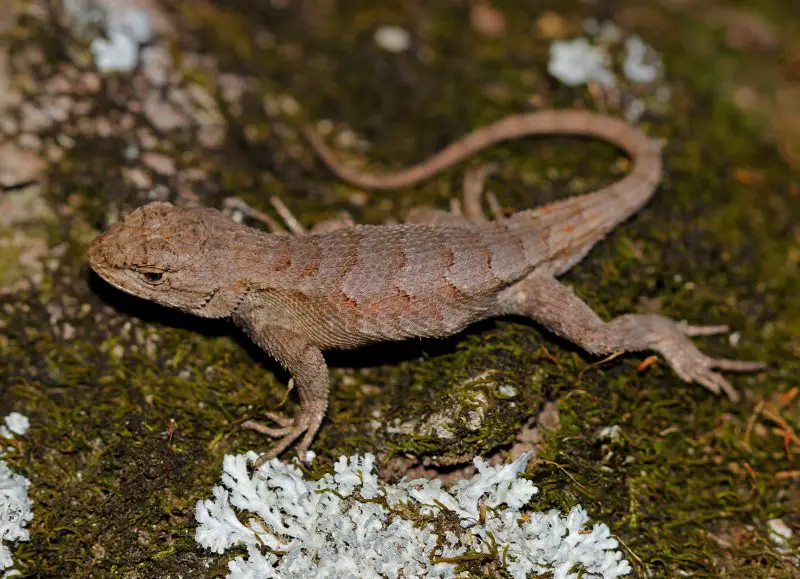
The Prairie Lizard is a spiny-scaled species with a relatively broad and flat body, usually colored in shades of brown and gray with subtle patterning. Adults measure about 4 to 6 inches long. Males display vibrant blue patches on their sides and bellies during mating season.
This species is identifiable by its rough, keeled scales and distinctive blue coloration on males. It is known for its bold behavior and can often be seen basking in the sun on rocks or soil. When threatened, it performs push-up displays and head bobs to warn off intruders.
In Texas, the Prairie Lizard is found in grasslands, prairies, and open woodlands. It feeds primarily on insects and spiders and is active during the day. Its habitat preferences and striking behavior make it a common sight in open, sunny environments.
Keeled Earless Lizard (Holbrookia propinqua)
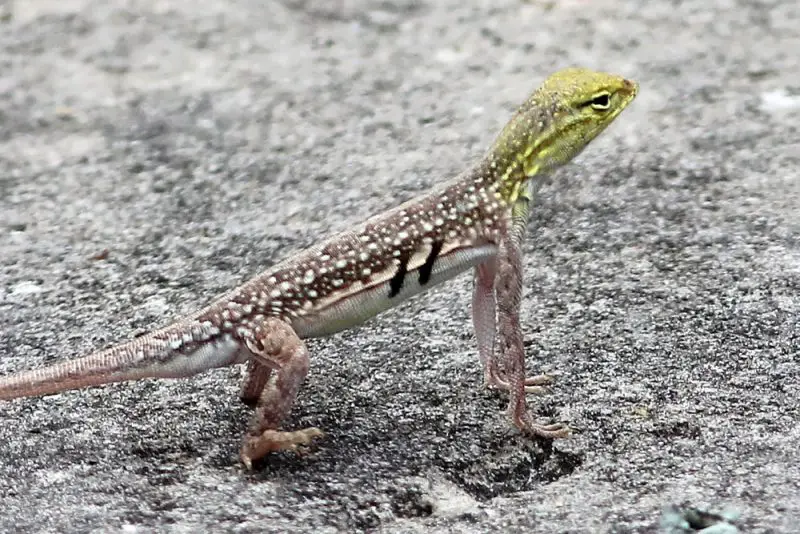
The Keeled Earless Lizard is named for its lack of external ear openings and the keeled (ridged) scales covering its body. It is relatively small, typically measuring around 4 inches in length, and displays a sandy or grayish color with dark spots or bands for camouflage.
Identification is aided by the absence of visible ears and the keeled texture of its scales. These lizards are quick and secretive, often darting under rocks or vegetation to avoid predators. During the breeding season, males may show faint color changes to attract females.
In Texas, the Keeled Earless Lizard inhabits dry, open areas such as sandy plains, scrublands, and deserts. It is diurnal and feeds mainly on ants and other small insects. Its adaptation to arid environments makes it well suited for survival in the harsher parts of the state.
Eastern Collared Lizard (Crotaphytus collaris)
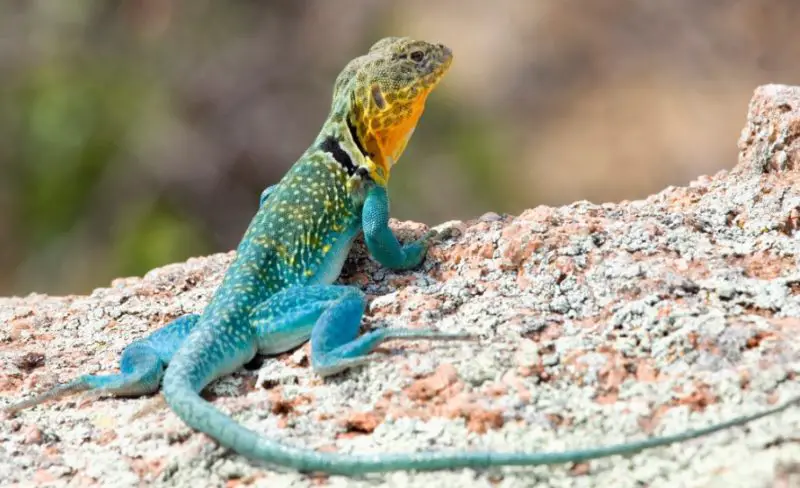
The Eastern Collared Lizard is a striking reptile, known for its bright colors and distinctive black bands around its neck that resemble a collar. Males are often more vibrantly colored than females, showcasing hues of green, yellow, and blue with spotted or striped patterns on their bodies. Adults typically reach lengths of 8 to 12 inches including the tail.
This lizard is easily identified by its large head, muscular build, and the two bold black collars that encircle its neck. It is an agile and fast-moving species, capable of running on its hind legs to escape threats. The Eastern Collared Lizard displays territorial behavior, often engaging in head bobbing and push-up displays to ward off rivals.
In Texas, it inhabits open, rocky areas, grasslands, and deserts where it basks in the sun. It preys primarily on insects, smaller lizards, and occasionally small mammals. Its bright coloration and active behavior make it one of the most noticeable lizards in its habitat.
Six-lined Racerunner (Aspidoscelis sexlineata)
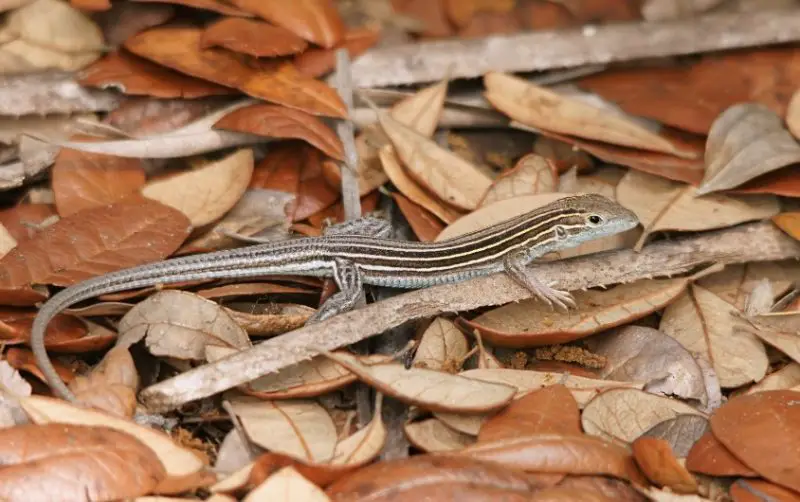
The Six-lined Racerunner is a slender and fast-moving lizard, named for the six distinct light stripes running down its back. It usually has a yellow to greenish background color with black lines, and adults grow to about 6 to 8 inches in length. Its streamlined body and long tail help it dart quickly through its environment.
Identification relies on the six prominent stripes and the racerunner’s quick, energetic movement. This species is known for its speed and agility, often seen running across open ground or through low vegetation. Males may display bright blue coloration on their tails during the breeding season.
In Texas, the Six-lined Racerunner occupies open habitats such as grasslands, prairies, and sandy areas. It is diurnal and insectivorous, feeding mainly on ants, beetles, and other small invertebrates. Its quick movements and distinctive stripes make it a common and recognizable species in suitable habitats.
Common Side-blotched Lizard (Uta stansburiana)
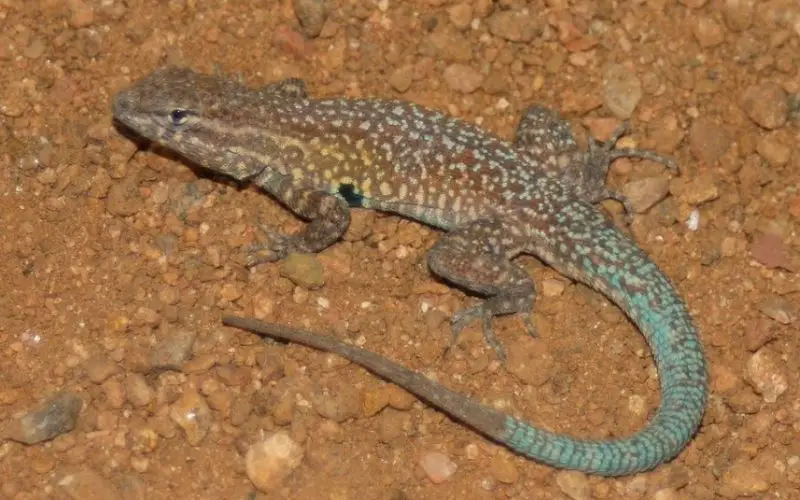
The Common Side-blotched Lizard is a small, robust lizard named for the dark blotch located just behind its front legs on each side. It typically measures around 3 to 5 inches in length and exhibits a range of colors from pale gray to reddish brown, often with spots or blotches.
Identification is straightforward due to the characteristic side blotches and its relatively small size. These lizards are known for their territorial behavior and can often be seen performing push-ups and head bobbing to communicate. They are also adept climbers, sometimes found on rocks or low vegetation.
In Texas, this species prefers dry, open areas such as deserts, rocky hillsides, and scrublands. It feeds primarily on insects and spiders and is active during the day. The Common Side-blotched Lizard’s adaptability helps it thrive in a variety of environments across the state.
Broad-headed Skink (Plestiodon laticeps)
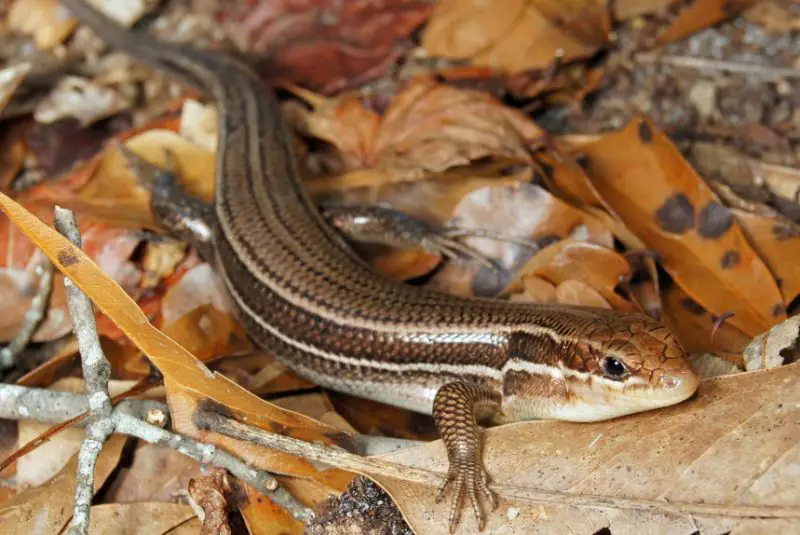
The Broad-headed Skink is the largest skink species in Texas, recognized by its broad, triangular head and smooth, shiny scales. Males develop a bright orange or red head during the breeding season, while the body is usually brown with faint stripes or spots. Adults can reach up to 12 inches in length including the tail.
This skink is identifiable by its size, broad head, and seasonal coloration. It is an excellent climber, often found in trees and shrubs as well as on the ground. Broad-headed Skinks are generally secretive but may become more visible during mating displays or when basking.
In Texas, it inhabits hardwood forests, woodlands, and suburban areas with abundant trees. It feeds on a variety of insects, spiders, and occasionally small vertebrates. Its arboreal habits and large size make it a fascinating and important predator in its ecosystem.
Four-lined Skink (Plestiodon tetragrammus)

The Four-lined Skink is a medium-sized skink with four distinct light stripes running along its dark brown or black body. It has smooth, shiny scales and grows to about 7 to 9 inches in length including the tail. Males may show subtle color changes during the breeding season.
Identification focuses on the four clear stripes and its slender body shape. These skinks are agile and often found near logs, rocks, or leaf litter where they seek shelter. They are diurnal and tend to bask in sunlight, retreating quickly if threatened.
In Texas, the Four-lined Skink prefers wooded areas, forest edges, and moist habitats with plenty of cover. Its diet consists mainly of insects and other small invertebrates. This species contributes to maintaining the balance of insect populations in its natural habitats.
Canyon Lizard (Sceloporus merriami)

The Canyon Lizard is a medium-sized reptile with rough, spiny scales and a coloration that blends well with rocky environments. It typically has a grayish to brown body with darker spots and blotches, growing to about 5 to 7 inches in length including the tail. Males often display brighter blue markings on their throats and bellies during breeding season.
Identification of the Canyon Lizard involves its spiny scales and preference for rocky canyons and cliff faces. It is an agile climber and uses its camouflaged coloring to avoid predators while basking on sunlit rocks. The species is known for its territorial behavior, including push-up displays and head bobs.
In Texas, this lizard is mostly found in the western part of the state, inhabiting arid, rocky areas. It feeds on insects and other small invertebrates. Its adaptation to rugged terrain makes it a resilient species in harsh desert environments.
Southwestern Fence Lizard (Sceloporus cowlesi)
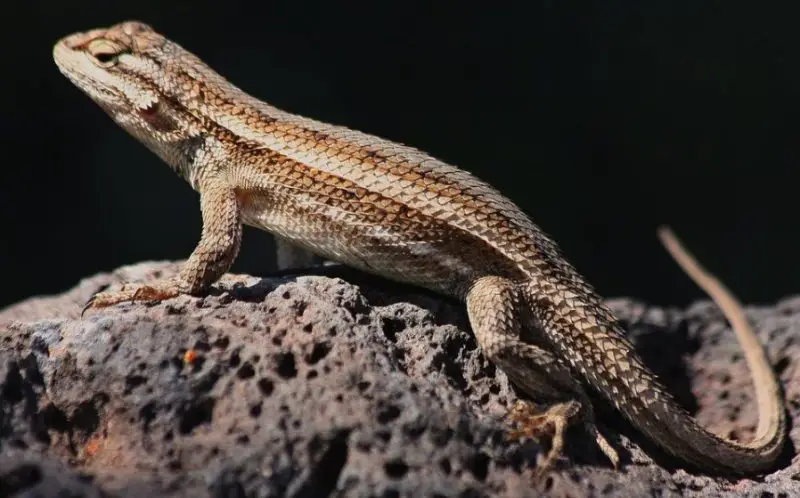
The Southwestern Fence Lizard is a spiny-scaled species characterized by its rough texture and muted coloration, usually brown or gray with faint patterns. Adults typically reach lengths of 4 to 6 inches. Males may show blue patches on the throat and belly during the breeding season.
This lizard can be identified by its habitat preference and spiny scales. It is an excellent climber, often seen on fences, rocks, and trees. Its behavior includes territorial displays such as head bobbing and push-ups to communicate with rivals and attract mates.
In Texas, the Southwestern Fence Lizard occupies arid and semi-arid regions, including scrublands and grasslands. It is insectivorous, feeding mainly on ants, beetles, and spiders. This species thrives in dry environments where it can find shelter among rocks and sparse vegetation.
Blue Spiny Lizard (Sceloporus cyanogenys)
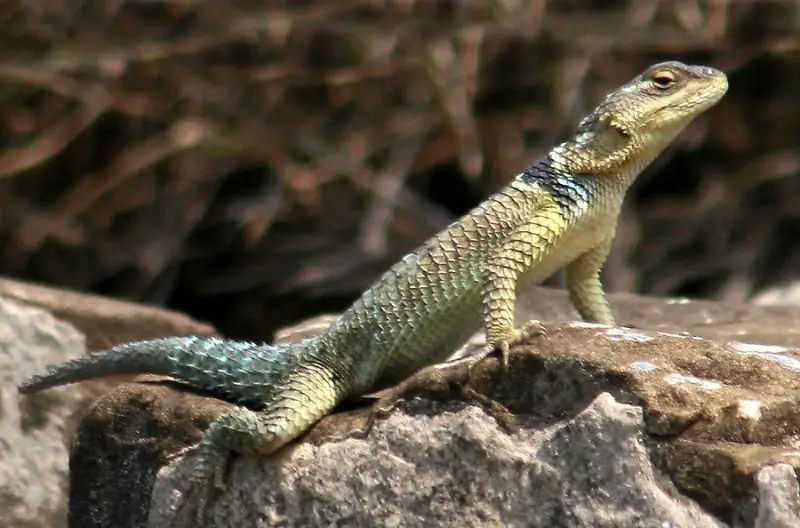
The Blue Spiny Lizard is named for the striking blue coloration found on the throats and sides of males. It has rough, keeled scales that give it a spiny appearance. Adults are medium-sized, measuring about 5 to 7 inches in total length.
Identification is straightforward because of the vivid blue markings and the textured scales. This species is territorial and often seen performing push-ups and head bobs as visual signals. It is an adept climber, commonly found on rocky surfaces and tree trunks.
In Texas, the Blue Spiny Lizard inhabits mountainous and rocky areas, favoring shaded crevices and ledges. Its diet consists mainly of insects, spiders, and other small arthropods. Its bright coloration and behavior make it a noticeable and fascinating species in its native range.
Texas Banded Gecko (Coleonyx brevis)

The Texas Banded Gecko is a small, nocturnal lizard recognizable by its banded pattern of light and dark stripes across its body. It typically measures 4 to 5 inches in length and has a slender body with a broad head and large eyes adapted for nighttime activity.
Identification is based on its distinctive banded pattern and the absence of external ear openings. This gecko is secretive and mostly active after dusk, hiding under rocks and debris during the day. It uses its tail for fat storage and can detach it to escape predators.
In Texas, the Texas Banded Gecko is found in dry, rocky, and sandy habitats, especially in the southwestern regions. Its diet consists mainly of small insects and arthropods. Its nocturnal nature and elusive behavior make it a unique member of the Texas lizard community.
Texas Alligator Lizard (Gerrhonotus infernalis)
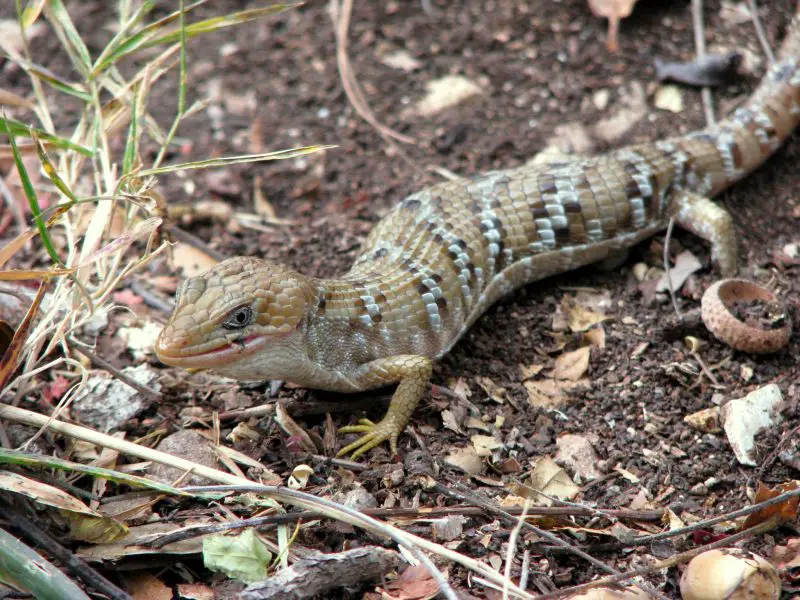
The Texas Alligator Lizard is a robust, elongated lizard with tough, overlapping scales resembling those of an alligator. It has a long tail and a distinctive broad head. Adults can reach lengths of up to 12 inches or more, making it one of the larger lizards in Texas.
Identification relies on its heavily armored appearance and slow, deliberate movements. Unlike many lizards, it has external ear openings but lacks the ability to detach its tail. This species is generally secretive, spending much time under logs, rocks, and leaf litter.
In Texas, the Texas Alligator Lizard inhabits rocky hillsides, wooded areas, and limestone outcrops, primarily in the Hill Country region. It feeds on insects, spiders, and occasionally small vertebrates. Its tough scales and shy nature make it well adapted to avoiding predators in its environment.
Gray-checkered Whiptail (Aspidoscelis dixoni)
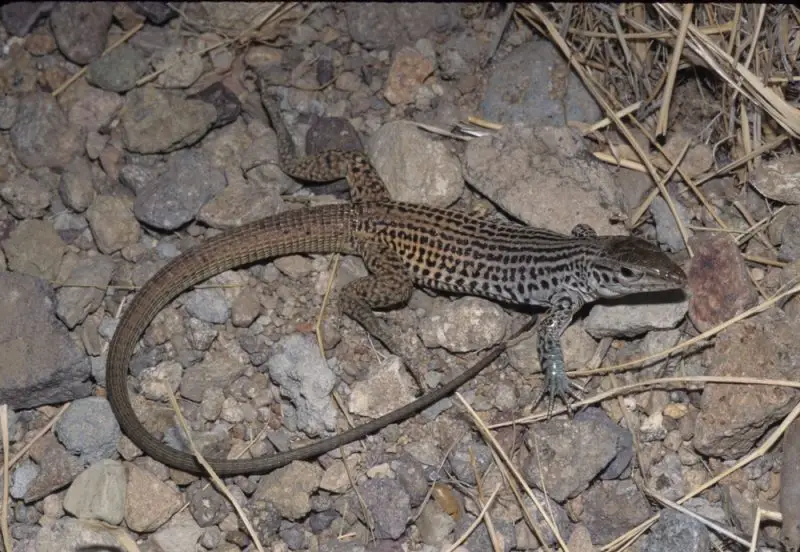
The Gray-checkered Whiptail is a slender, fast-moving lizard characterized by a gray or brown body covered with a pattern of checkered spots or small blotches. It typically reaches lengths of 6 to 8 inches including the tail. This species is known for its agility and long tail, which can be twice the length of its body.
Identification centers on its checkered pattern and quick movements. It is often seen darting across open ground and using its speed to escape predators. Gray-checkered Whiptails are diurnal and primarily insectivorous, feeding on ants, beetles, and other small arthropods.
In Texas, this lizard inhabits arid and semi-arid regions such as deserts, scrublands, and rocky areas. It prefers open spaces with sparse vegetation where it can easily spot threats and forage effectively. Its elusive behavior helps it thrive in challenging environments.
Roundtail Horned Lizard (Phrynosoma modestum)
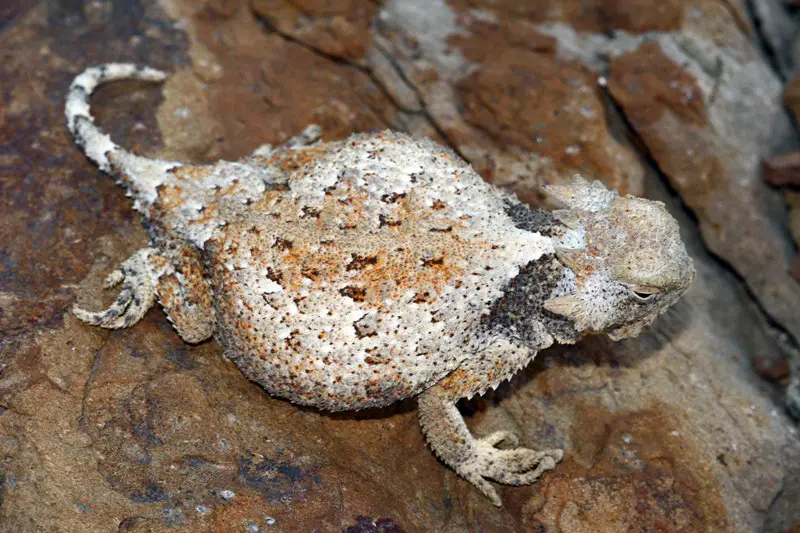
The Roundtail Horned Lizard is a small, flattened lizard with a round tail and distinctive spiny scales covering its body. It is usually gray or brown with subtle mottling that blends into sandy or rocky terrain. Adults grow to about 3 to 4 inches in length, including the tail.
This species is identified by its round tail, spiny body, and camouflaged coloration. Unlike some horned lizards, it has less pronounced horns but retains a rough, textured appearance. It remains still to avoid detection and can squirt blood from its eyes as a defense mechanism.
In Texas, the Roundtail Horned Lizard inhabits desert and semi-desert areas of the western part of the state. It feeds mainly on ants and other small insects, relying on its camouflage and quick reflexes for protection. Its specialized diet and habitat make it an interesting member of the horned lizard family.
Chihuahuan Spotted Whiptail (Aspidoscelis exsanguis)
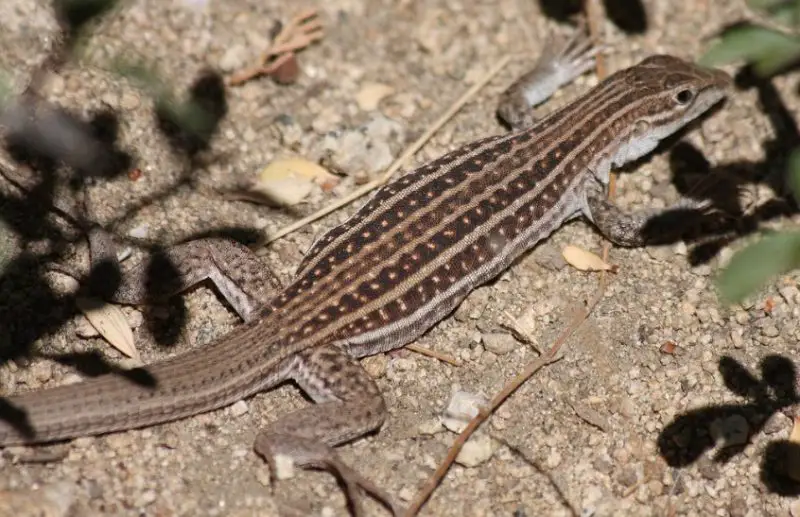
The Chihuahuan Spotted Whiptail is a slender, agile lizard with a light-colored body marked by irregular dark spots and a long, whip-like tail. It usually measures 6 to 8 inches long including the tail. This species is known for its swift movements and keen eyesight.
Identification relies on its spotted pattern and the long tail characteristic of whiptails. It is active during the day and often seen running rapidly across open, rocky terrain. Males may display brighter colors during the breeding season to attract females.
In Texas, this whiptail occupies arid habitats in the western region, including deserts and rocky outcrops. It feeds primarily on insects and other small invertebrates. Its ability to thrive in harsh environments makes it a resilient species in the Lone Star State.
Great Plains Skink (Plestiodon obsoletus)
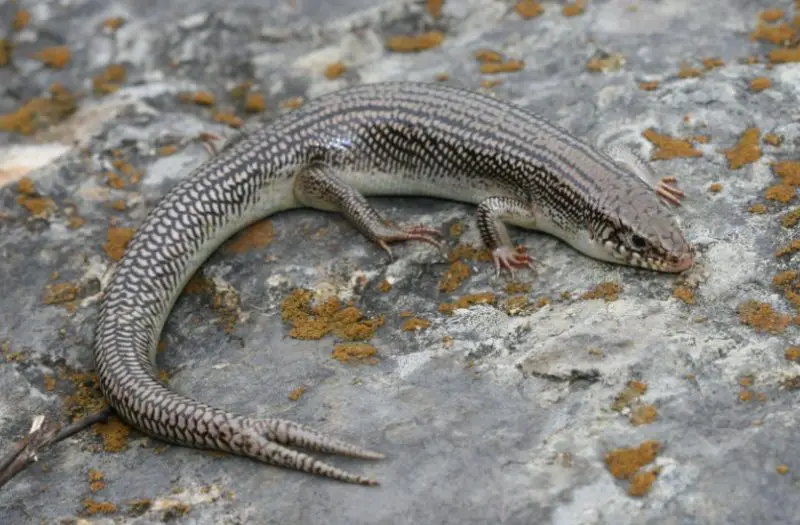
The Great Plains Skink is one of the largest skinks found in Texas, with a robust body and smooth, shiny scales. It has a brown to gray coloration with subtle patterning and can grow up to 12 inches in length including its long tail. Males and females show little difference in appearance.
Identification is straightforward due to its large size and smooth scales. This skink is an excellent burrower and often hides under rocks, logs, or loose soil. It is generally shy and will retreat quickly when disturbed.
In Texas, the Great Plains Skink inhabits grasslands, open woodlands, and prairies, especially in the northern and western parts of the state. It feeds on a variety of insects, spiders, and small vertebrates. Its size and habitat preferences make it an important predator within its ecosystem.
Spot-tailed Earless Lizard (Holbrookia lacerata)

The Spot-tailed Earless Lizard is a small, slender species named for the distinctive spots near the base of its tail and the absence of external ear openings. Its coloration varies from sandy beige to gray with darker spots and occasional faint striping. Adults grow to about 4 to 5 inches long.
This species can be identified by its spot patterns and earless appearance. It is fast and agile, often seen darting across sandy or rocky terrain in search of prey. Males may display bright throat coloration during the mating season.
In Texas, the Spot-tailed Earless Lizard is found in arid and semi-arid habitats, including deserts and scrublands in the southern and western regions. It feeds mainly on ants, beetles, and other insects. Its unique adaptations help it avoid predators and survive in harsh environments.
Marbled Whiptail (Aspidoscelis marmorata)
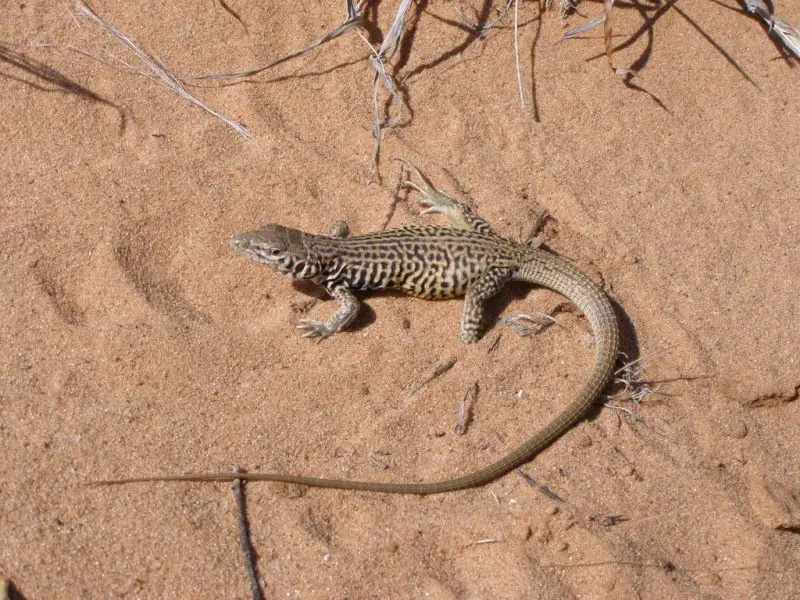
The Marbled Whiptail is a slender lizard known for its distinctive marbled pattern of light and dark patches covering its body. It usually measures 6 to 8 inches in total length, with a long, whip-like tail that aids in balance and quick movements. Its coloration ranges from gray to brown, blending well with rocky and sandy habitats.
Identification is primarily based on its marbled appearance and active behavior. This species is fast and agile, often seen darting across open terrain in search of insects. It is diurnal and highly alert, using speed to escape predators.
In Texas, the Marbled Whiptail inhabits dry, rocky areas and grasslands, mostly in the western parts of the state. Its diet consists mainly of ants, beetles, and other small arthropods. The lizard’s excellent camouflage and swift reflexes help it survive in the arid environments of Texas.
Little Striped Whiptail (Aspidoscelis inornata)
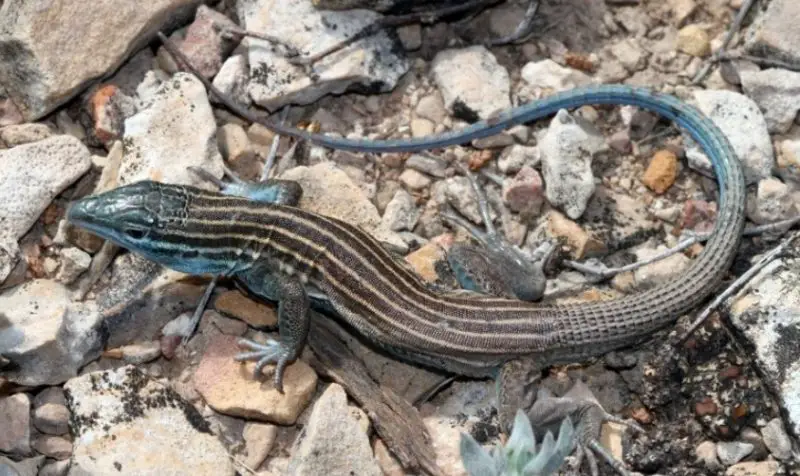
The Little Striped Whiptail is a small, slender lizard characterized by its subtle, faint striping along the body. It generally reaches 5 to 7 inches in length, including the tail. Its coloration is often a pale brown or tan with delicate stripes that run longitudinally down the back.
Identification involves noting the faint stripes and the lizard’s active, rapid movements. It is an agile species, frequently seen running across open sandy or grassy areas. This whiptail is known for its speed and alertness during the day.
In Texas, the Little Striped Whiptail is found mainly in arid and semi-arid habitats across western and central regions. It feeds primarily on insects and other small invertebrates. Its discreet coloring and nimble behavior allow it to avoid predators efficiently.
Plateau Spotted Whiptail (Aspidoscelis septemvittata)
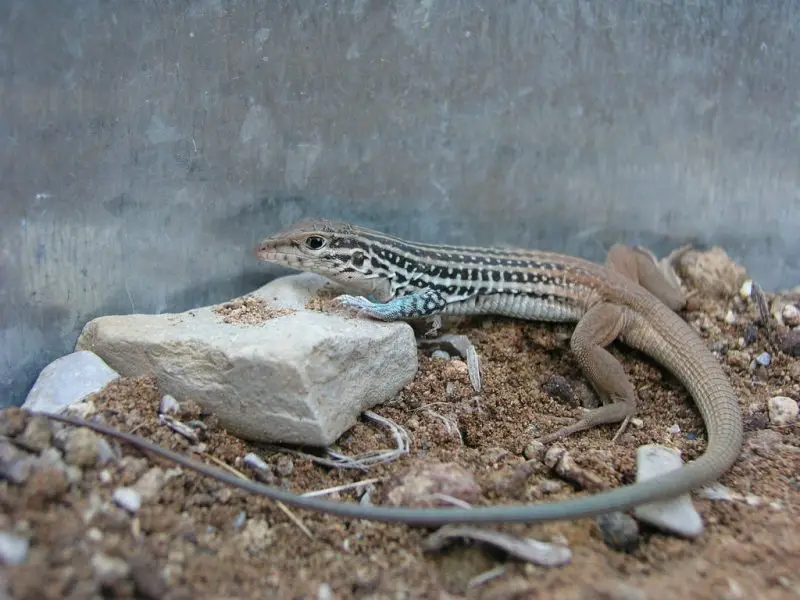
The Plateau Spotted Whiptail is recognized by its pale body adorned with scattered dark spots and a series of faint stripes running longitudinally. It usually grows to about 6 to 8 inches long. This lizard has a slender build with a long, whip-like tail aiding in balance and agility.
Identification hinges on its spotted and striped pattern combined with its quick, darting movements. It is commonly seen basking in sunny, open areas before quickly retreating when threatened. This whiptail is diurnal and highly insectivorous.
In Texas, the Plateau Spotted Whiptail inhabits rocky plateaus, grasslands, and semi-arid environments, particularly in the western and central parts of the state. It mainly feeds on ants, beetles, and spiders. Its behavior and habitat preferences make it a resilient species in tough conditions.
Lesser Earless Lizard (Holbrookia maculata)

The Lesser Earless Lizard is a small, slender lizard lacking external ear openings, giving it its common name. Its coloration varies from sandy tan to gray, often with dark spots or blotches on the body. Adults typically reach 4 to 5 inches in length.
Identification is based on its earless appearance and spotting pattern. This lizard is swift and secretive, commonly seen darting over sandy or rocky ground. Males may display bright coloration on their throats during the breeding season.
In Texas, the Lesser Earless Lizard occupies dry, open habitats such as deserts and grasslands, primarily in western regions. Its diet consists mainly of small insects and arthropods. Its adaptations help it conserve moisture and avoid predators in arid environments.
Graphic Spiny Lizard (Sceloporus grammicus)
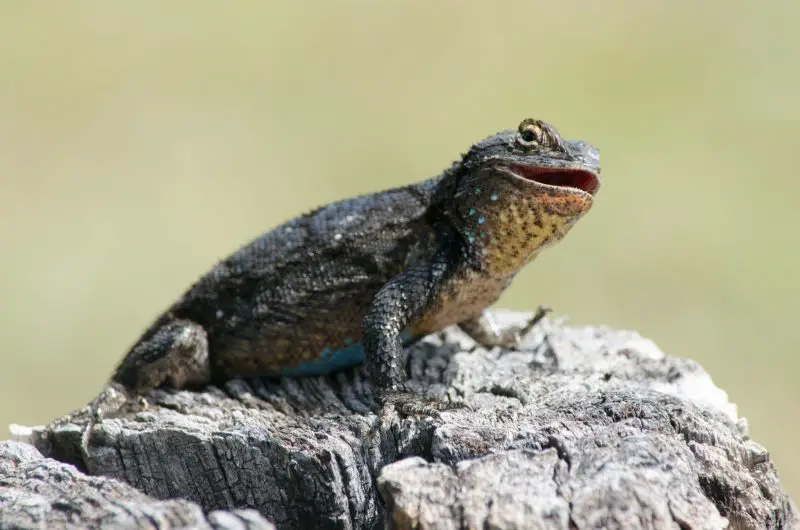
The Graphic Spiny Lizard is a medium-sized reptile with rough, keeled scales and a distinctive pattern of lines and blotches across its body. It usually measures 5 to 7 inches long. Males often show bright blue markings on their throats and sides during the breeding season.
Identification relies on its rough scales and intricate, graphic-like patterning. This lizard is territorial and displays head bobbing and push-ups to communicate. It is an adept climber, frequently found on rocks and tree trunks.
In Texas, the Graphic Spiny Lizard inhabits rocky hillsides and woodland edges in the western parts of the state. Its diet mainly consists of insects and spiders. Its striking pattern and behavior make it a notable species among Texas lizards.
Greater Short-horned Lizard (Phrynosoma hernandesi)

The Greater Short-horned Lizard is a stout-bodied reptile notable for its broad, flattened body and short, horn-like projections on the back of its head. It typically measures between 2.5 to 4 inches in length and is colored in various shades of brown, gray, or reddish tones that blend with the soil.
Its identification is made easy by its distinct horns, short limbs, and wide body. This lizard often remains motionless when threatened, relying on its camouflage. It can also perform a unique defense behavior: squirting blood from its eyes to deter predators.
In Texas, this species is found in the cooler, higher elevation grasslands and rocky areas of the western Panhandle. Its diet mainly includes ants, especially harvester ants, but it also consumes other small insects. Its tolerance of cooler climates sets it apart from other horned lizards.
Reticulate Collared Lizard (Crotaphytus reticulatus)
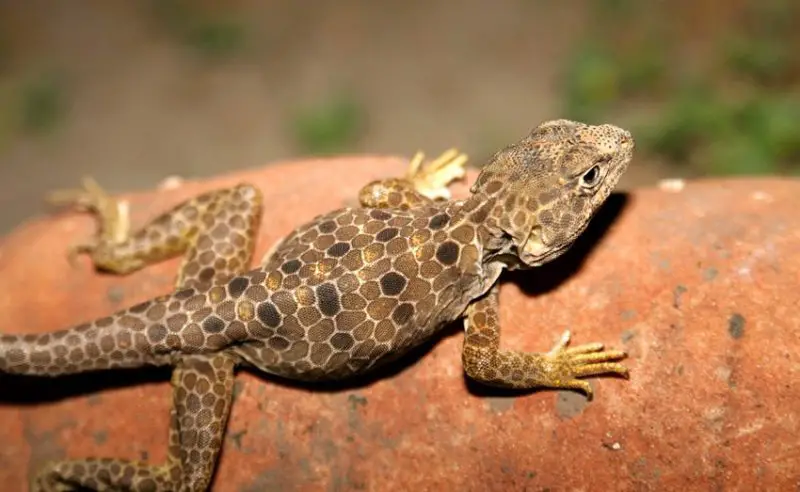
The Reticulate Collared Lizard is a large, muscular lizard recognized by its bold pattern of dark net-like lines over a lighter background and the two black collars around its neck. Adults can grow up to 14 inches long, with a powerful build and long tail.
This species is identifiable by its reticulated pattern and prominent collars, which contrast with its vibrant body. Males are especially colorful during the breeding season, displaying green, blue, or yellow hues. They are strong runners and capable of bipedal locomotion.
In Texas, the Reticulate Collared Lizard is mainly found in the rocky terrains of southern and western regions near the Mexican border. It prefers dry, open habitats with scattered vegetation. As an active predator, it feeds on insects, other lizards, and even small rodents.
Twin-spotted Spiny Lizard (Sceloporus bimaculosus)
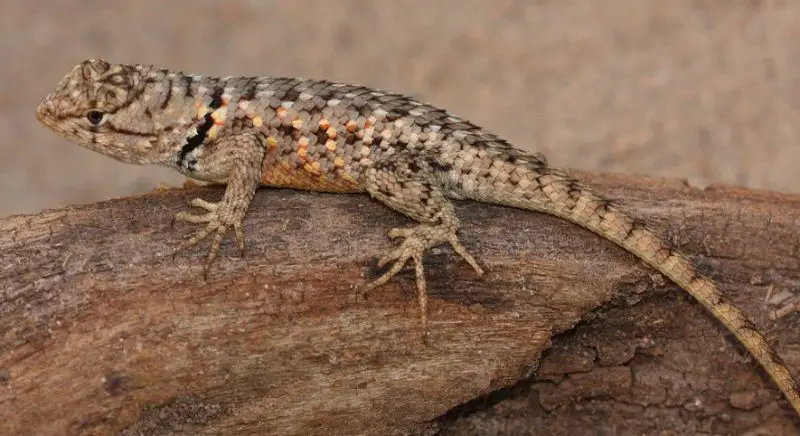
The Twin-spotted Spiny Lizard is a moderately sized reptile with rough, keeled scales and two dark spots located behind its shoulders. Its overall coloration includes gray or brown tones with subtle striping and spotting, aiding in camouflage.
It is named for the two dark blotches near the front limbs, a key identification feature. This species exhibits typical spiny lizard behaviors like basking on rocks and performing push-ups as a display to rivals or threats. Males may show some blue coloration on the sides and belly.
In Texas, the Twin-spotted Spiny Lizard is restricted to a few rocky, arid habitats in the Trans-Pecos region. It often shelters in rock crevices and feeds on a diet of ants, beetles, and spiders. Its secretive nature makes sightings uncommon in the wild.
Reticulated Gecko (Coleonyx reticulatus)

The Reticulated Gecko is a small, nocturnal lizard distinguished by its delicate, soft skin and the reticulated, net-like pattern across its body. Typically 3 to 4 inches in length, this gecko is tan or pinkish with darker brown markings and a slender build.
Unlike many lizards, it lacks sticky toe pads and is more terrestrial in behavior, preferring to scurry across rocky or sandy surfaces. It is identified by its soft, smooth scales, prominent eyes without eyelids, and slow, deliberate movements at night.
In Texas, the Reticulated Gecko is found in the dry, rocky areas of South Texas near the Rio Grande. It hides under rocks or debris during the day and emerges at night to feed on small insects and spiders. Its cryptic coloration and elusive habits make it hard to detect.
Many-lined Skink (Plestiodon multivirgatus)
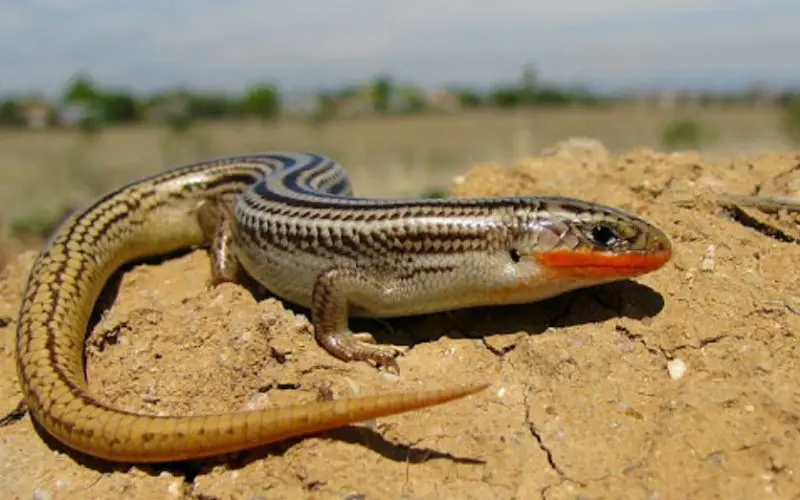
The Many-lined Skink is a slender, elongated lizard with smooth, shiny scales and numerous light stripes running from head to tail. It typically reaches 5 to 7 inches in length, and its body is usually gray to brown with white or yellow lines.
Identification centers on its many thin stripes and glossy appearance. Juveniles may have bright blue tails, which fade with age. This skink is secretive and spends much of its time hiding under logs, rocks, or leaf litter, making it hard to observe.
In Texas, the Many-lined Skink is mostly found in the northern Panhandle, especially in grasslands and forest edges with loose soil or debris. It preys on small insects and other invertebrates. Its fossorial behavior helps it avoid predators and extreme temperatures.
Dunes Sagebrush Lizard (Sceloporus arenicolus)
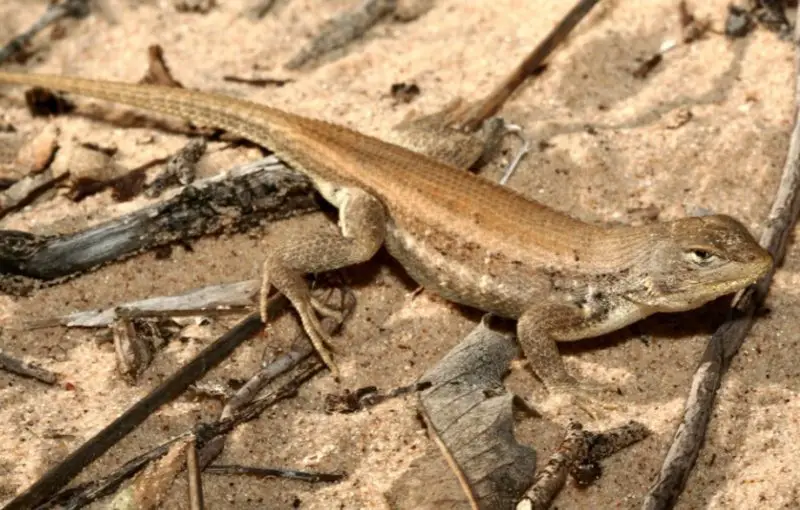
The Dunes Sagebrush Lizard is a small, sand-dwelling lizard known for its pale gray or tan coloration that blends perfectly with its sandy environment. It typically measures about 2.5 to 3.5 inches in length and has distinctive dark crossbands and granular scales.
This species is easily identified by its muted coloration, rough texture, and preference for shinnery oak sand dunes. It is a habitat specialist and has adapted to life among shifting dunes, where it uses burrows and low vegetation for shelter and protection from predators.
In Texas, the Dunes Sagebrush Lizard is found only in a limited area of the southern High Plains, specifically in sandy habitats with shinnery oak in the western part of the state. Due to its narrow range and habitat specificity, it is considered a species of conservation concern.
Laredo Striped Whiptail (Aspidoscelis laredoensis)

The Laredo Striped Whiptail is a sleek, fast-moving lizard marked by six to seven light stripes running the length of its dark brown or black body. Adults typically range from 6 to 9 inches long and have long, slender tails and limbs.
This species is parthenogenetic, meaning all individuals are female and reproduce without males. Its striped body and rapid, darting movements make it identifiable in the wild. It is highly active during the day and avoids predators by running quickly and using ground cover.
In Texas, it is commonly found in southern regions near Laredo and surrounding counties. Its habitat includes open woodlands, grasslands, and suburban areas with loose soil and leaf litter. It feeds primarily on small insects and spiders.
Western Spiny-tailed Iguana (Ctenosaura pectinata)

The Western Spiny-tailed Iguana is a large, robust lizard with rough, spiny scales on its tail and back. Adults can grow up to 4 feet in length, with coloration that ranges from gray and black to brown, often featuring darker bands or blotches.
This species is recognized by its large size, heavily spined tail, and stout body. It is primarily herbivorous but will also eat insects and smaller animals. Known for its climbing ability, it often perches on rocks, walls, or trees and can be quite territorial.
In Texas, the Western Spiny-tailed Iguana is an introduced species, mainly found in the southern parts of the state, especially in urban areas near the Mexican border. It prefers rocky or urban environments with plenty of hiding places and basking sites.
Prairie Skink (Plestiodon septentrionalis)

The Prairie Skink is a small, secretive skink with smooth, shiny scales and a slender body. Adults usually measure around 5 to 7 inches in length. Its coloration varies from brown to gray, with light stripes on the sides and, in juveniles, a vivid blue tail.
This species is identified by its glossy appearance and lateral striping. It is most active during warm days but often hides under logs, rocks, or leaf litter. Males develop orange coloration on the jaw during the breeding season.
In Texas, the Prairie Skink is limited to the northern regions, particularly in prairies, grasslands, and open woodlands. It thrives in areas with loose soil for burrowing and prefers habitats with moderate moisture. It feeds on small invertebrates and insects.
Keeled Rock Gecko (Cyrtopodion scabrum)

The Keeled Rock Gecko is a small, nocturnal gecko with rough, keeled scales and a mottled appearance. Typically growing up to 5 inches long, it is gray or tan with irregular dark markings that provide excellent camouflage against rocky surfaces.
This gecko is easily identified by its textured skin and slender build. It is primarily active at night and can often be seen on walls, rocks, or around artificial lights where it hunts insects. Its eyes are large and lack eyelids, a common trait among geckos.
In Texas, the Keeled Rock Gecko is an introduced species, likely established in urban areas of southern Texas. It favors rocky or human-made environments and can survive in arid and semi-arid regions. Its adaptability allows it to persist alongside native lizards.
Long-nosed Leopard Lizard (Gambelia wislizenii)
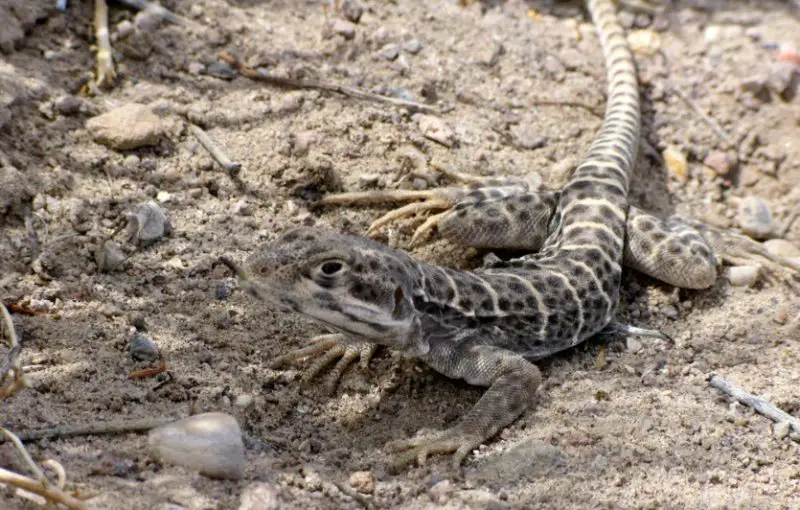
The Long-nosed Leopard Lizard is a striking reptile distinguished by its long snout, large head, and leopard-like spots covering a pale tan or gray body. Adults can grow up to 10 inches in length, including the tail, and their markings often help them blend into desert surroundings.
This lizard is known for its strong hind legs and ability to leap impressively when escaping predators. It is a sit-and-wait predator, feeding on insects, other lizards, and even small rodents. During the breeding season, females may develop reddish or orange hues on their sides and belly.
In Texas, the Long-nosed Leopard Lizard is found in the western parts of the state, particularly in arid, open desert scrublands with sparse vegetation. It prefers sandy or rocky soils and uses its strong limbs to dig shallow burrows or shelter under rocks and shrubs.
Desert Grassland Whiptail (Aspidoscelis uniparens)
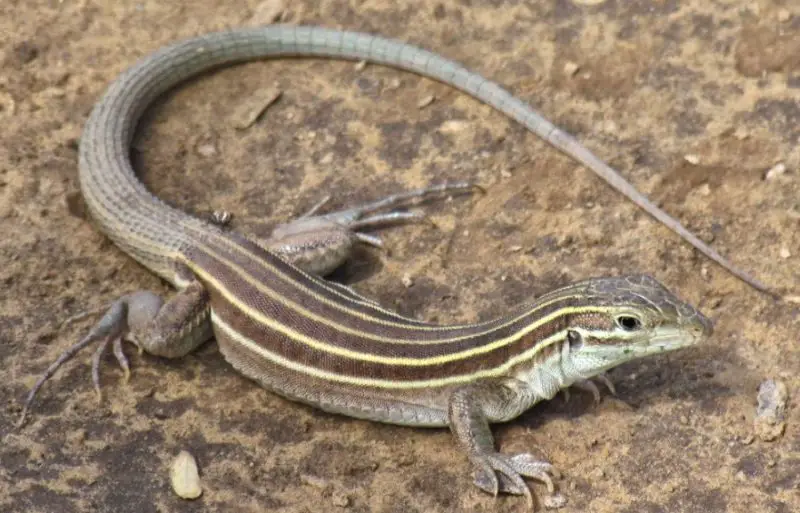
The Desert Grassland Whiptail is a sleek, fast-moving lizard with a narrow body and long tail. It features dark coloration with six to seven light-colored stripes running from head to tail. Adults typically reach 6 to 10 inches in total length.
This species is all-female and reproduces through parthenogenesis, meaning it can lay viable eggs without mating. It is highly active during the day and quickly darts through grassy or shrubby areas in search of ants, termites, and other small invertebrates.
In Texas, the Desert Grassland Whiptail is found primarily in the Trans-Pecos region. It inhabits dry grasslands and desert plains with loose soil. The lizard is elusive and wary of danger, often hiding beneath rocks or vegetation to avoid predators.
New Mexico Whiptail (Aspidoscelis neomexicana)
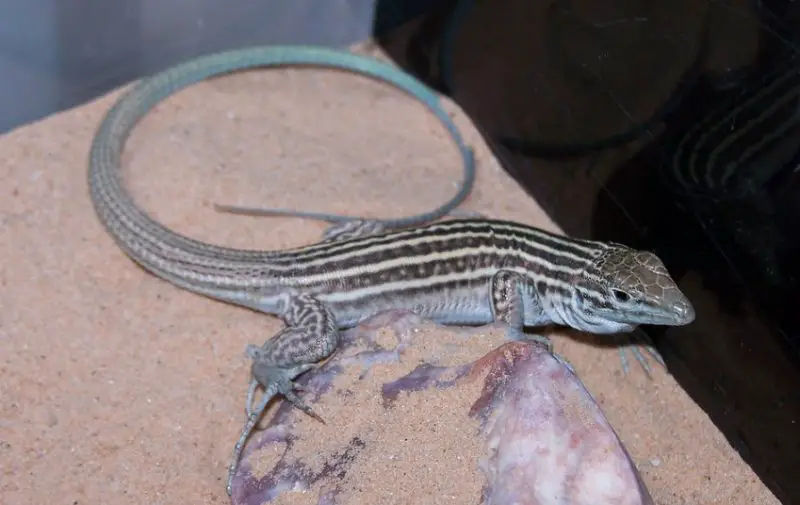
The New Mexico Whiptail is a slender, energetic lizard marked by six to seven yellow or white stripes over a dark green or brown back. It grows up to 8.5 inches long and has a long tail that aids in balance and speed.
Like many other whiptail species, the New Mexico Whiptail is parthenogenetic, with only females present in the population. It is insectivorous, feasting on beetles, ants, and other small arthropods. It is often seen actively foraging in the mornings and late afternoons.
In Texas, this species occurs in the western regions near the border with New Mexico. It favors arid, sandy soils, desert scrub, and grasslands, often using burrows or natural ground cover to hide during the heat of the day or when threatened.
Asian House Gecko (Hemidactylus frenatus)

The Asian House Gecko is a small, adaptable lizard with a translucent body and slightly rough, granular skin. Adults are typically 3 to 5 inches long and range in color from pale gray to light brown with faint patterns.
It is a nocturnal species and often spotted near artificial lights, feeding on moths and insects attracted to the glow. The Asian House Gecko is known for its distinctive chirping calls and its ability to cling to vertical surfaces, including glass and ceilings.
In Texas, it is an introduced species found mainly in urban areas along the Gulf Coast and southern regions. It thrives around human habitation, where it finds ample food and shelter. It competes with native gecko species in some parts of its range.
Tropical House Gecko (Hemidactylus mabouia)

The Tropical House Gecko is a medium-sized gecko with smooth skin and a robust body. Adults measure about 4 to 6 inches long and exhibit mottled coloration in shades of tan, gray, or brown. Their large eyes are well-suited for night vision.
This species is easily recognized by its rounded snout, broad toes, and bumpy tail. It is nocturnal and often found indoors or on exterior walls, preying on small insects. Unlike some geckos, it is more tolerant of disturbance and can thrive in high-density human areas.
In Texas, the Tropical House Gecko is most commonly seen in southern cities and suburban areas. It prefers warm, humid environments and often shares space with people in homes, sheds, and gardens. It has become well-established due to its adaptability and rapid reproduction.
Sagebrush Lizard (Sceloporus graciosus)
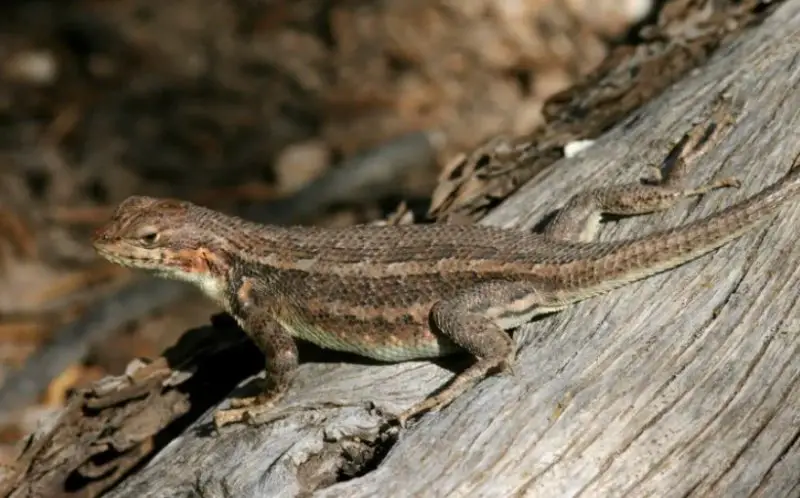
The Sagebrush Lizard is a small, agile species that typically grows up to 5.5 inches in length. It is covered in rough, keeled scales and has a brown to gray coloration with faint banding and a lighter underside. Males often display blue patches on their belly and throat, especially during the breeding season.
This lizard is diurnal and spends much of its time basking in the sun or darting through low vegetation and ground cover in search of insects. It uses visual signals like head-bobbing and push-ups as part of its territorial and mating behaviors.
In Texas, the Sagebrush Lizard is found primarily in the western and northern parts of the state, favoring dry, open woodlands, sagebrush flats, and rocky slopes. It thrives in arid and semi-arid habitats with plenty of places to hide under rocks, logs, or leaf litter.
Southern Spot-tailed Earless Lizard (Holbrookia subcaudalis)
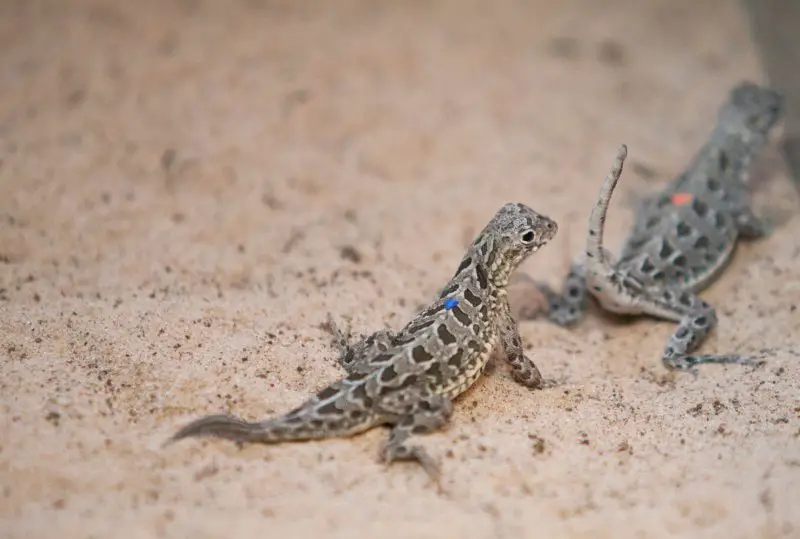
The Southern Spot-tailed Earless Lizard is a slender and swift reptile with a body length of up to 4 inches, excluding the tail. It lacks external ear openings, giving it the “earless” name. Its coloration blends well with sandy environments, typically gray or light brown with dark speckles and a distinctive dark spot near the tail base.
This lizard is highly active during the day and prefers to run rather than climb. It feeds primarily on insects and other small arthropods, using quick bursts of speed to catch prey. Males can become more vividly colored during the breeding season.
In Texas, this species is native to the southern part of the state, particularly in sandy soils of scrublands, grasslands, and coastal plains. It buries itself in the loose substrate to escape heat and predators, and often uses shallow burrows for refuge.
Desert Spiny Lizard (Sceloporus magister)
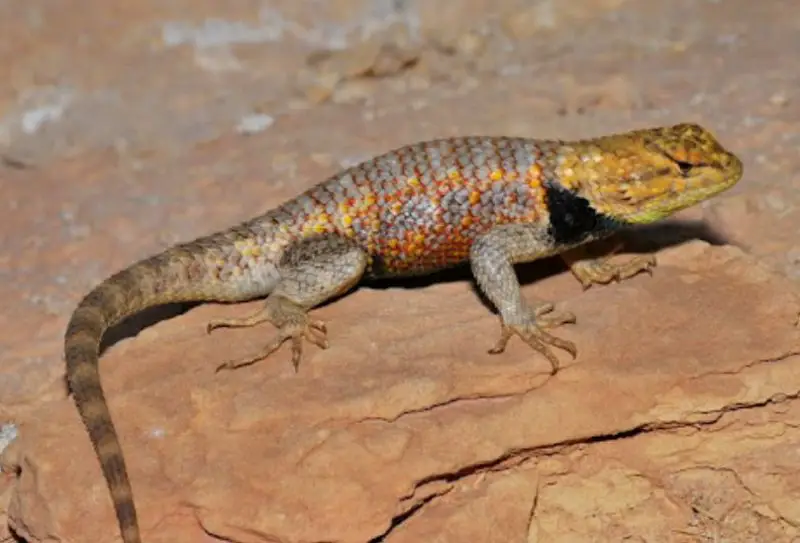
The Desert Spiny Lizard is a robust, medium-to-large lizard that can grow up to 11 inches long. It has rough, spiny scales and a generally dark body with mottled patterns of black, brown, and gray. Males exhibit bright blue patches on the belly and sides when breeding.
This species is known for its bold and territorial behavior. It spends a lot of time basking on rocks, fences, or tree trunks and often scurries into crevices when disturbed. Its diet consists mostly of insects, spiders, and occasionally small vertebrates.
In Texas, the Desert Spiny Lizard is primarily found in the western deserts and mountainous regions. It prefers rocky outcrops, canyon walls, and desert scrub habitats. Its adaptability allows it to occupy a range of elevations and microclimates within arid zones.
Eastern Fence Lizard (Sceloporus undulatus)
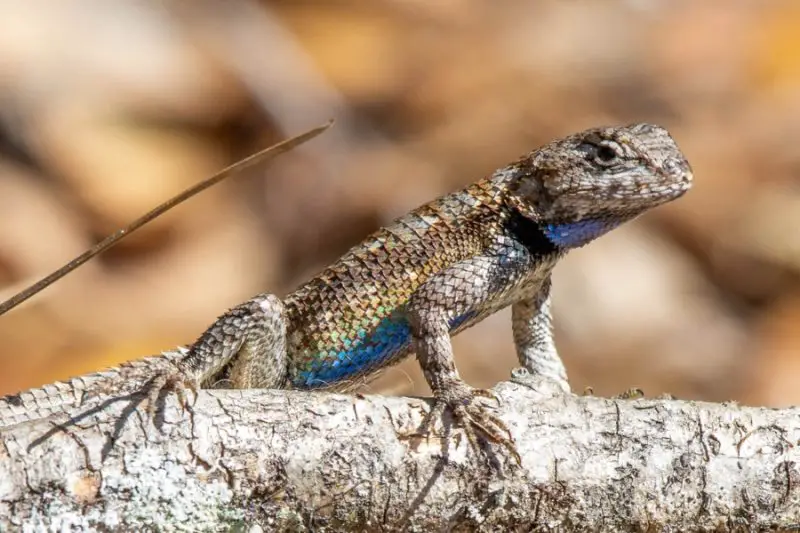
The Eastern Fence Lizard is a common, well-known lizard with a stout body and spiny scales. Adults are gray to brown with dark, wavy crossbands across the back. Males are usually more colorful, with bright blue patches on the throat and belly during the breeding season.
It is a skilled climber and frequently seen on fences, trees, and logs. This diurnal lizard is active in warm temperatures, feeding on a variety of insects such as beetles, ants, and caterpillars. It is also known for its push-up displays used in mating and territorial disputes.
In Texas, the Eastern Fence Lizard is widespread across the eastern and central parts of the state. It thrives in forested areas, woodland edges, and suburban backyards where trees and brush provide both basking spots and cover.
Blue Spiny Lizard (Sceloporus cyanogenys)

The Blue Spiny Lizard is a large, striking species easily recognized by its vivid blue and turquoise coloration, especially in adult males. Its body can reach up to 13 inches long, with coarse, keeled scales and a robust build that give it a formidable appearance.
These lizards are diurnal and bask openly on rocks, logs, and walls. They are territorial and use physical displays like head-bobbing to ward off rivals or attract mates. Their diet includes insects, spiders, and occasionally smaller lizards.
In Texas, the Blue Spiny Lizard is found in the southern regions, including the Rio Grande Valley and parts of the Hill Country. It prefers rocky, arid landscapes and brush-covered hillsides where it can quickly retreat into crevices when threatened.
Green Iguana (Iguana iguana)
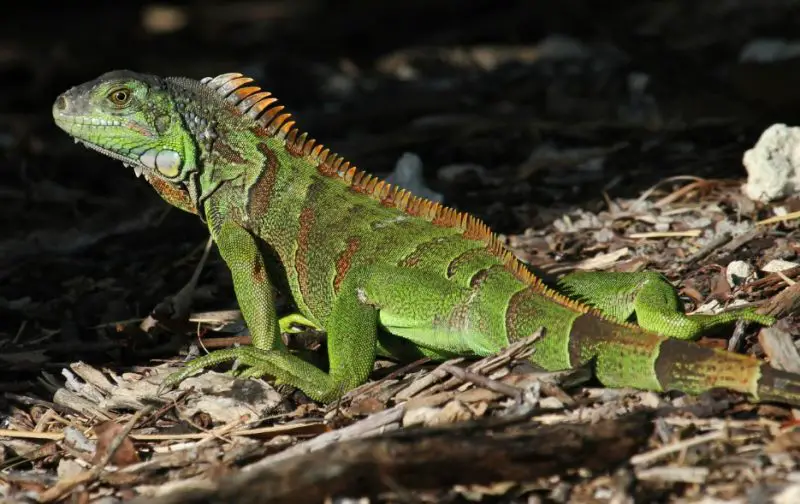
The Green Iguana is one of the largest lizard species found in Texas, often growing over 5 feet in length including the tail. It has a striking appearance with bright green to dull gray-green coloration, a long whip-like tail, a row of spines down its back, and a prominent dewlap under its chin. Juveniles are typically more vivid in color, while adults may become darker with age.
Primarily herbivorous, Green Iguanas feed on leaves, flowers, and fruits. They are diurnal and arboreal, often basking on tree branches near water. Although not native, they have established populations in southern Texas due to the pet trade and escapees. Iguanas are known to be excellent swimmers and may escape danger by diving into water.
In Texas, Green Iguanas are found mainly in urban and subtropical areas of the southernmost parts of the state, particularly near the Gulf Coast. They prefer warm, humid environments with plenty of vegetation and are most commonly seen in trees, on rooftops, or along canals and rivers.
Coal Skink (Plestiodon anthracinus)
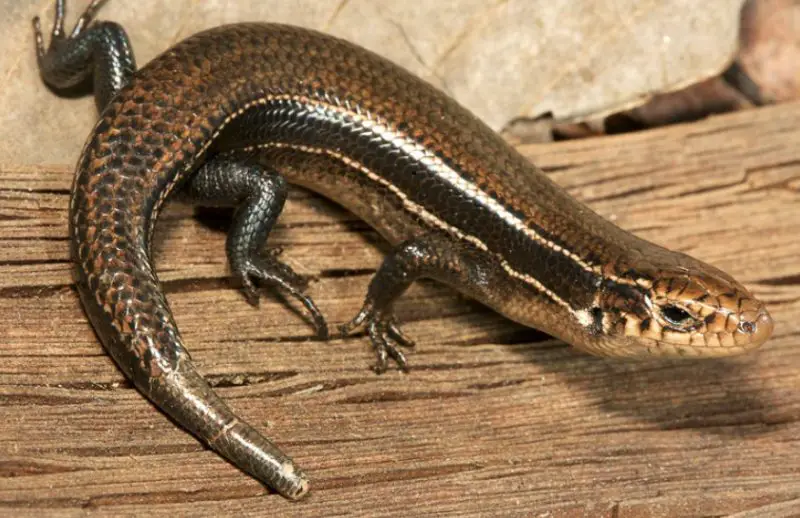
The Coal Skink is a secretive, medium-sized skink that grows to about 5 to 7 inches in total length. It is typically dark brown to black with four light stripes running along the body from head to tail, and lacks a mid-dorsal stripe. Juveniles often have a bright blue tail, which fades as they mature.
Coal Skinks are ground-dwellers and are often found under rocks, logs, and leaf litter in moist, wooded environments. They are quick to hide when disturbed and rely on their smooth, shiny scales and streamlined bodies to move easily through dense vegetation and debris. Their diet consists of insects, spiders, and other small invertebrates.
In Texas, the Coal Skink is found in the eastern and southeastern parts of the state, particularly in forested hillsides and areas with abundant cover near streams or springs. They require damp microhabitats and are rarely seen out in the open, making sightings relatively uncommon.
Speckled Earless Lizard (Holbrookia approximans)
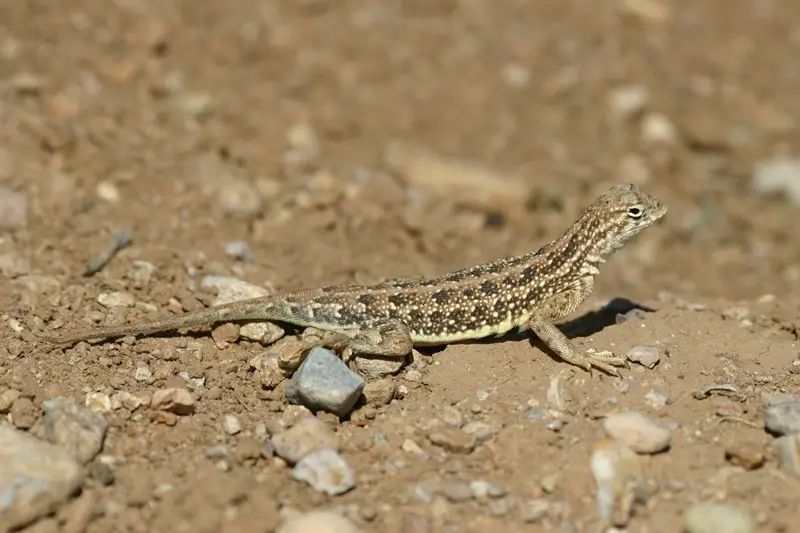
The Speckled Earless Lizard is a small, slender lizard with a total length of about 5 inches. It is named for the lack of external ear openings, which is thought to help prevent sand from entering while burrowing. Its coloration is typically pale tan or gray, with a fine speckling of black or brown and dark markings near the tail.
This diurnal species is very active and fast-moving, relying on speed and camouflage to evade predators. It feeds on small insects and spiders and often uses shallow burrows or natural ground depressions for shelter. Like other earless lizards, it may freeze or bury itself in the sand when threatened.
In Texas, the Speckled Earless Lizard is found in dry, sandy, or gravelly habitats in the western and central regions of the state. It prefers open areas with sparse vegetation and loose soils, such as desert scrublands and prairie grasslands, where it can efficiently thermoregulate and remain hidden.


